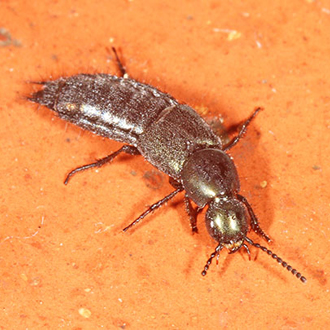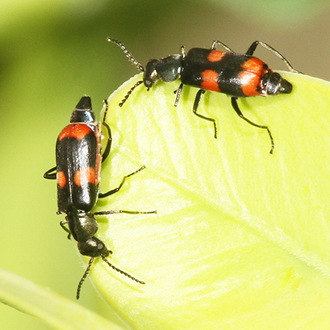

 |
 |
 |
 |

|
 |

|

|
 |

|
 |
 |

|  |

|

|  |

|
 |
 |
 |
 |
 |

|
 |
 |

|
 |
 |

|

|

|

|
 |

|

|
 |

|
 |

|

|

|
|
Ladybirds are shown on a separate page but there are hundreds of other Coleoptera (beetles) found in gardens. Here is a selection photographed in my garden in reigate between 2012 and 2015. Cockchafers (Melolontha melolontha, 35mm), also known as May-bugs, are vegetarian relatives of Dung Beetles, feeding on foliage. Adults are seen, as the name suggests, mainly in May. They fly - rather noisily and clumsily - at night and can give cyclists a nasty crack in the face. They can be daunting if coming through an open window too. The larvae gorge themselves on roots in the ground for three years and the resulting beetle stays buried underground for another winter, meaning the life cycle is more than four years. The smaller Summer Chafer (Amphimallon solstitialis, 20mm) is seen later in the year, from June to August, and has a shorter life cycle though still one that lasts years. When trying to find mates they fly around tree tops at dusk or in the night, often in large numbers, and it is not uncommon to find them dead or dying in a pond the morning after, having fallen in exhausted. The pictured one was luckier and made its escape. Possibly the most attractive of the chafers is the Welsh Chafer (Hoplia philanthus, 9mm), Violet Ground Beetles including Carabus problematicus, 25mm, are impressive as both larvae and adults and can turn up anywhere with woodland close by. They are predatory and active at night though they can appear in daylight too, as the pictured larva did while scurrying for cover. Ground Beetles feed on slugs, smaller invertebrates and fruit and are able to defend themselves to some extent against predators by discharging acid from the abdomen. Their armoury also includes the capacity to run fast when required. Smaller ones include the impressive brass-coloured Notiophilus biguttatus (6mm) and Calathus melanocephalus (6mm). The Black-headed Cardinal Beetle (Pyrochroa coccinea, 15mm) is one of our most impressive beetles and happily it seems to be doing well at the moment after being in the doldrums for a number of years. This beetle is a predator and an ancient woodland indicator. The Red-headed Cardinal (Pyrochroa serraticornis, 15mm) is altogether commoner. Not so bright but also imposing, the Rhinoceros Beetle (Sinodendron cylindricum, 13mm) gets its name from the pointed projection on the face of the male, as in the image here. This is a pretty common beetle and one whose larvae feed in decaying wood, with beech a favourite. Longhorn beetles are among the most iconic in the Coleoptera and there are plenty around, especially as they often go on flower heads so can be spotted relatively easily. Their often bright colouring helps as well, with the Yellow and Black Longhorn (Strangalia maculata, 15mm) a case in point. This is a great basker on foliage or flowers and flies in a noticeably undulating manner. The larvae feed on decaying deciduous wood. A similarly common but smaller longhorn, which can gather in numbers on single flower heads from June to August, is Judolia cerambyciformis (12mm). They too are believed to develop in deciduous wood but as with so many invertebrates, even those frequently encountered, precise details are in short supply. Probably the most widespread and commonest longhorn is the fairly dark Common Grammoptera (Grammoptera ruficornis, 10mm). Other longhorns include the White-banded Longhorn (Poecilium alni, 7mm), a small species which used to be very scarce but seems to be increasing in numbers, the Black-striped Longhorn (Stenurella melanura, 12mm), the Tobacco-coloured Longhorn (Alosterna tabacicolor, 12mm) and the Plum Longhorn (Tetrops praeustus, 6mm). The last-named is one of the smallest of the family and has disproportionately long antennae. Most of these species use various deciduous trees for breeding. Eight other species are shown on the beetles page in the Woodland and Hedgerow section of this website. The attractive Twin-spotted Oak Borer (Agrilus biguttatus, 15mm), which appeared briefly in the garden in 2011, used to be rare but has been increasing in numbers ever since the storm of 1987. It is associated with mature oak trees and by inference with sudden oak death but apparently the beetle is not the cause of the disease. It merely accelerates the damaging effects by infesting trees already 'under the influence' since the the larvae feed on the inner bark. There are numerous oak trees in the park behind the garden.The European Oak Borer (Agrillus sulcicollis, 12mm) is also an oak specialist and was seen egg laying in an oak stump at the end of my garden in 2014. Rove beetles in the Staphylinidae family Among the click beetles, Ampedus elongantulus (12mm) is none too common but very dashing whereas Kibunea minuta is monochrome and small at only 6mm or so. Dermestid beetles have a fairly bad reputation for attacking food and/or fabric. Megatoma undata (6mm) is nationally scarce and is not synanthropic; it has twice appeared in the structure containing my aculeate nesting boxes. Anthrenus fuscus (4mm) commonly lays eggs on woollen carpets or clothing which result in voracious 'woolly bear' larvae. Adults are regular visitors to umbellifers. The bean weevil Bruchidius villosus (3.5mm) is commonly found on broom plants. So-called woodworm beetles include the nationally scarce Hedobia imperialis (6mm), which has an association with ivy, oak and hawthorn. The Fan-bearing Wood-borer (Ptilinus pectinicornis, 5mm) attacks a range of hardwoods. Its larvae are predated by the chequered beetle Tillus elongatus (8mm), a nationally scarce species. The spider beetle Ptinus sexpunctatus (5mm) eats detritus in the nests of solitary bees such as the Red Mason Bee and some wasps. Anthocomus fasciatus (4mm) and the Common Malachite (Malachius bipustulatus, 6mm) are both soft-winged flower beetles, sun-loving species that spend a lot of time in the open on flowers and foliage. The False Ladybird (Endomychus coccineus, 6mm) is the best known of the so-called handsome fungus beetles. It lives on or close to fungoid wood, chiefly beech or birch. Tumbling flower beetles like umbellifers and have an obvious tip to the end of the abdomen. Mordellochroa abdominalis (5mm) is relatively common and the larvae often use ash. Variimorda villosa (7mm) is nationally scarce. Females have been seen laying eggs in old beech and pine stumps. Ischnomera cyanea (10mm) is a nationally scarce pollen-feeding beetle which can be found on umbellifers. The Wasp Nest Beetle (12mm) has fascinating life cycle. Eggs are laid on decayed wood and if social wasps arrive to harvest wood fibre for their nest the beetle larvae attempt to climb on their backs. If successful, they are transported to the nest and each finds a wasp grub to parasitise. Large numbers can emerge from some wasp nests but generally this beetle is not often seen. Anyone who feeds birds will know of, or will have used, mealworms and the Yellow Mealworm Beetle (Tenebrio molitor, 12mm) is the species which results from the larvae in wild and free conditions. The species is regarded as a pest since the larvae eat stored grain. The Hawthorn Leaf Beetle (Lochmaea crataegi, 5mm) is common and uses other plants besides hawthorn. The Common Red Soldier Beetle (Rhagonycha fulva, 9mm) is incredibly easy to see, usually on umbellifers and often coupled. The Oak Pinhole-borer (Platypus cylindrus, 6mm) is the only member of its family in Britain. It was formerly nationally scarce but records are increasing. Dead wood used includes beech, ash and sweet chestnut in addition to oak. Images © Jeremy Early. All rights reserved. In 2013 I published My Side of the Fence - the Natural History of a Surrey Garden. Details may be found, and orders placed, via this hyperlink My Side of the Fence. In November 2015 Surrey Wildlife Trust published the atlas Soldierflies, their allies and Conopidae of Surrey, jointly written by David Baldock and me. Details are on this web page: Atlas. |